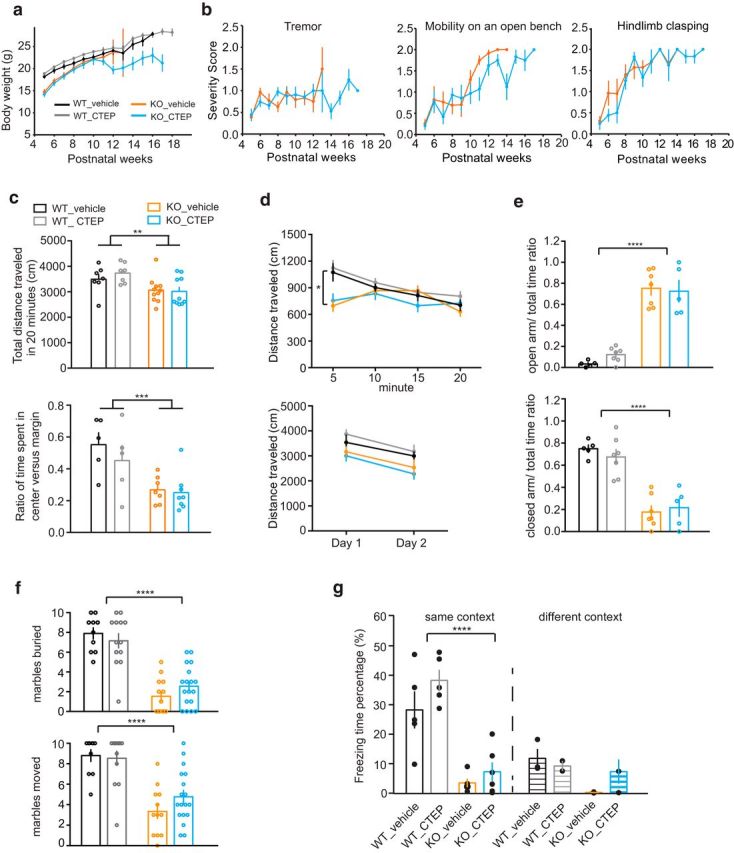Figure 6.

CTEP treatment of Mecp2 KO mice does not improve body weight, tremor, hindlimb clasping, mobility, or anxiety deficits. a, b, CTEP treatment does not improve body weight, tremor, hindlimb clasping, or mobility on an open bench (severity score: 0 equals WT, 1 is partially impaired, 2 is severely impaired). c, Open-field test showing that Mecp2 KO mice traveled less than WT littermates in a 20 min window regardless of vehicle or CTEP treatment (2-way ANOVA, genotype p = 0.0025, treatment and interaction ns, WT_V n = 7, WT_CTEP n = 7, KO_V n = 11, KO_CTEP n = 10). The same open-field test also showed that Mecp2 KO mice spent less time in the center versus margin of the test arena compared with WT littermates regardless of vehicle or CTEP treatment (2-way ANOVA, genotype p = 0.0006, treatment and interaction not significant, WT_V n = 5, WT_CTEP n = 5, KO_V n = 7, KO_CTEP n = 8). d, Open-field test on the first day divided into bins of 5 min showed that, whereas WT littermate ran the most distance during the first 5 min and then gradually reduced exploration, Mecp2 KO mice did not reach peak exploration until 10 min later (2-way RM-ANOVA, WT_V vs KO_V: interaction p = 0.0004, time p < 0.0001, genotype p = 0.103; KO_V vs KO_CTEP: interaction p = 0.0591, time p = 0.0093, treatment p = 0.8284). Open-field test on 2 consecutive days showed that both WT and KO mice regardless of drug treatment habituated to the environment (2-way RM-ANOVA, WT_V vs KO_V: interaction p = 0.776, time p = 0.003, genotype p = 0.22; KO_V vs KO_D: interaction p = 0.737, time p = 0.0003, treatment p = 0.477). e, Regardless of CTEP treatment, compared with WT, Mecp2 KO mice spent more time in the open arm than in the closed arm in the elevated plus maze (WT_vehicle_open arm: 0.033 ± 0.013 n = 5; WT_CTEP_open arm: 0.121 ± 0.027 n = 7; KO_vehicle_open arm: 0.752 ± 0.065 n = 7; KO_CTEP_open arm: 0.725 ± 0.102 n = 5; WT_vehicle_closed arm: 0.749 ± 0.034 n = 5; WT_CTEP_closed arm: 0.675 ± 0.067 n = 7; KO_vehicle_closed arm: 0.177 ± 0.056 n = 7; KO_CTEP_closed arm: 0.216 ± 0.078 n = 5, 2-way ANOVA, genotype p < 0.0001). f, Mecp2 KO mice were impaired in a marble-burying test and CTEP treatment did not significantly improve the displacement of marbles (2-way ANOVA, only genotype is significant for both marbles that are moved and marbles that are displaced, p < 0.0001). g, WT mice regardless of CTEP treatment showed robust freezing behavior in the same context but little freezing in a different context (WT_vehicle_same context: 28.26 ± 6.3% n = 5; WT_CTEP_same conext: 38.26 ± 3.64% n = 5; WT_vehicle_different context: 11.84 ± 3.18% n = 3; WT_CTEP_different context: 9.23 ± 1.72% n = 2). Mecp2 KO mice regardless of CTEP treatment showed little freezing behavior in either the same or different context (KO_vehicle_same context: 3.48 ± 1.44% n = 5; KO_CTEP_same context: 7.29 ± 3.18% n = 6; KO_vehicle_different context: 0.25 ± 0.15% n = 2; KO_CTEP_different context: 7.34 ± 4.12% n = 3). Comparison of WT and KO in the same context condition: 2-way ANOVA, interaction p = 0.45, treatment p = 0.099, genotype p < 0.0001.
